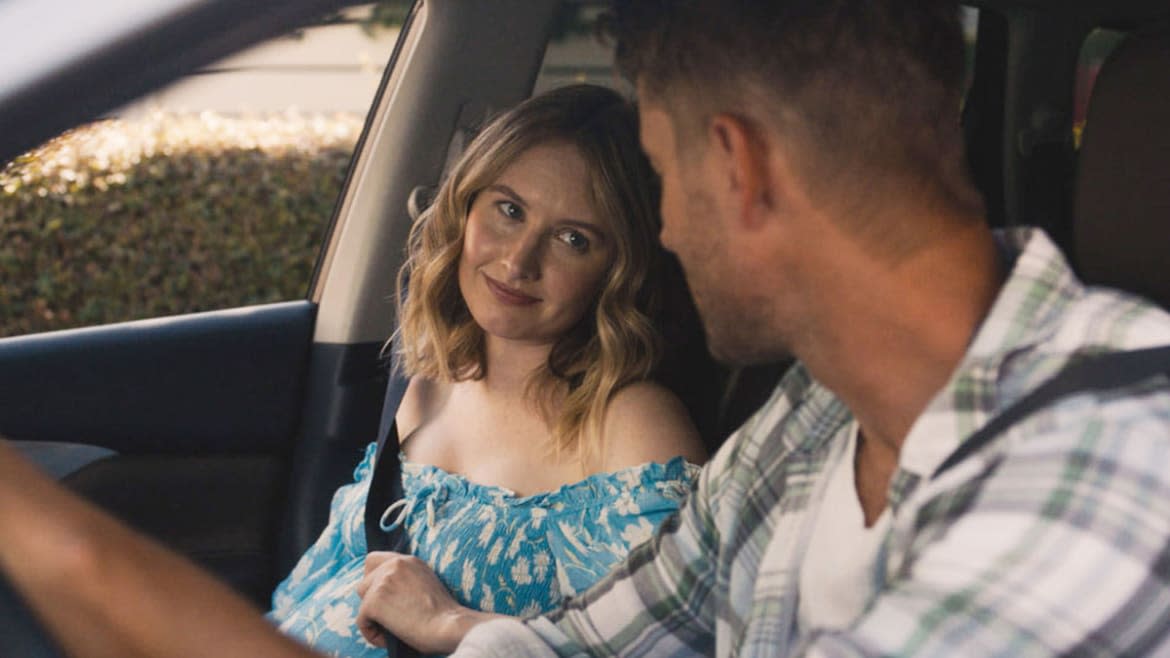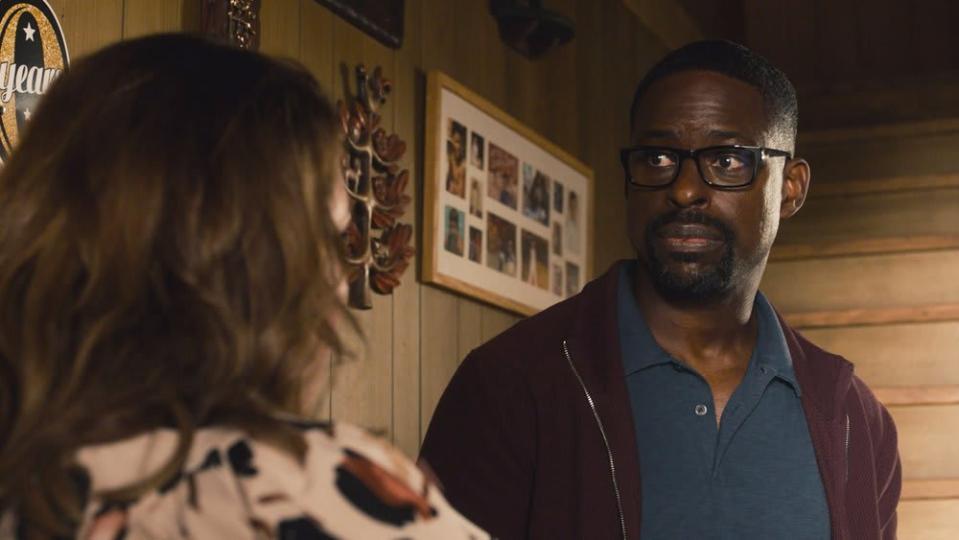The Coronavirus Infects ‘This Is Us’: Welcome to TV’s New COVID Nightmare

In the first moments of Tuesday night’s This Is Us premiere, Madison (Caitlin Thompson) confides to Kevin (Justin Hartley) her stress about being pregnant with twins at this particular moment. “It feels like this is all happening just as the world is falling apart,” she says.
“The virus thing?” he responds, dating the events of the two-part, two-hour premiere to the stretch of spring when the coronavirus was making its way to America. “Madison, trust me, I’m a movie star. I think if there was really something to worry about my agent would have…” He stops because he’s interrupted by a phone call—and also, probably, the reality of what exactly is to come.
And thus launches what will be, from a pop-culture standpoint, our new normal. Or, depending on how you look at it—and on your feelings about this show—our new nightmare.
The first draft of pandemic programming is over. Shows that were scripted during the start of lockdown, filmed through Zoom videos, or self-shot in performers’ homes documented the first, often awkward, subjectively unpleasant attempts at dramatizing these unprecedented times for TV.
Love in the Time of Corona, Coastal Elites, Connecting…, and Social Distance were admirable, if uneven experiments. Those efforts strived to bottle the lightning storm of emotions and fears of those first spring months but were unable to keep up with the pace and escalation of it all, often becoming either quaint or pandering.
But now we have TV shows back in production on actual sets. We have long-running, beloved series returning, forced to reckon with how the pandemic would alter the lives of the characters we’ve followed and loved. COVID is scheduled to factor into a slew of returning fall TV series, including Grey’s Anatomy and Superstore, both of which will chronicle how essential workers are affected by it. And This Is Us might be the first big fan-favorite to come back with the coronavirus as a major character.
By the time the season five premiere wrapped, that first exchange of dialogue between Madison and Kevin ended up seeming an appropriate introduction to how the drama series was going to handle COVID in its storylines.
The instinct is to flinch when Kevin just casually drops “the virus?” bomb, a name-check so visceral given everything that’s going on it’s as if he just uttered your own name and transported you into the series. And if your instinct is to eye roll at the delusional, in hindsight, way he initially downplays its seriousness, it likely won’t be the last time you’ll roll them.
The episode speeds through the naivete of character’s attitudes in the first few months of the pandemic, bumbles its way through over-explaining social distancing protocols that allow the family to be together, and eventually calls out a veritable BINGO card of traumas from the seven months since the series last aired. (Even the underappreciation of the One Day at a Time reboot gets airtime, should the episode not already feel like a surreal hall of mirrors.)
That said, there is something tangibly different about seeing COVID introduced to a series that already existed, rather than watching one of those new shows centered around it. It may even be more palatable.
One consequence of these last seven months of separation from loved ones, not to mention the pall of disease and death, is that people are thinking more about family: how much they miss them, and how memories are having to stand in for actual time together. There is something undeniably emotional, then, of watching those very things mirrored in the Pearsons.
This Is Us: Once a cryfest, always a cryfest. You can imagine how a pandemic loosens the tap on those tears.
The CliffsNotes version of the premiere’s set-up is that, as mentioned before, Kevin and Madison are expecting twins after a one night stand. His own twin sister—and Madison’s best friend—Kate (Chrissy Metz) is adopting a second child with Toby.
Mom Rebecca (Mandy Moore) is showing early signs of Alzheimer’s, and third pillar of the Pearson Big Three, Randall (Sterling K. Brown), is not speaking to Kevin after a blow-up fight in the previous season finale that ended with, “Hand to God, Randall, the worst thing that happened to me is the day they brought you home.” Yowza!
It’s a bird’s nest of plot lines even before you introduce a pandemic.
We see Randall’s kids trading rumors about how serious they’ve heard the virus is. Beth (Susan Kelechi Watson) sounds an alarm when she reads that Tom Hanks was diagnosed. “Hanks got the corona?!” Randall asks in disbelief. His daughter Deja echoes the gravity of it: “People are gonna wake up now.” And now we live in a world where Tom Hanks being the first celebrity to contract COVID is a plot point on This Is Us.
It takes about four minutes for the first “oh my god, it’s a This Is Us character wearing a mask” moment to happen, and, truth be told, it is that shocking to see. From there, it’s a Who’s Who of early pandemic talking points, as dramatized by the Pearsons: six-feet apart outdoor meet-ups, hand sanitizer, PPE, business loans, quarantines, lockdowns lasting longer than anyone thought, Zooms, virtual therapy sessions, the Karens, crumbling finances, and then the most dramatic one: the Black Lives Matter movement.
In what may be the most affecting thread woven into the two-hour premiere, Randall and Beth are shaken by George Floyd’s death. It forces Randall to grapple with his feelings about his racial identity having grown up as the adopted son of a white family. His family, chiefly Kate, is at a loss over how express their heartache for him, though Kate makes the white-girl mistake of dumping emotional labor on Randall. Their frank talk about it is possibly the strongest scene in the episode.

There are flashbacks to the day that Jack (Milo Ventimiglia) and Rebecca went to the hospital so that she could give birth, which is also the day that Randall was born and left at the doorstep of a fire station. As they weave together, you learn more about Randall’s parents, specifically his mother, and what that day was like for them than you had in previous seasons. That leads to a last-second twist that is juicy, if egregiously soapish.
But the major set piece of the two hours is the 40th birthday celebration for the Big Three, a celebration that is happening a) in a pandemic and b) without Randall, who is too mad at Kevin and still grappling with his feelings in the wake of George Floyd’s killing to attend.
If your first question is, “How are they justifying this birthday celebration in which the entirely family (sans Randall) is gathered in a cabin together?” then rest assured the show works so feverishly to explain it you can practically see the sweat.
There is a frantic explanation of who got tested when and how long they’ve been quarantining together for and who is six feet away from who. It’s the broadcast TV drama version of that Kim Kardashian tweet from earlier in the afternoon—or, you know, every asshat friend you have who posts selfies on a beach trip with 10 friends with a monologue caption of why it’s somehow safe.
That’s to say nothing of the somewhat maddening, if meta, experience of knowing that you’re watching actors on a set together, which means they’ve been treated to intense and expensive COVID testing protocols in order to return to a semblance of their normal. Meanwhile, so many essential people who need rapid testing don’t have access to it, and we’re all watching them from our continued lockdowns amid warnings from local politicians not to travel to see family for the holidays.
But this is part of that new normal. If we’re going to be watching scripted dramas that take place in current times, there’s going to have to be the gymnastics floor routine to explain how any situation in which two characters are together is possible... and it’s unlikely many will stick that landing. Still, it is my understanding that gymnastics scoring includes bonus points for degree of difficulty, and an enterprise like that earns the grading curve.
It’s not that long ago that scripted broadcast TV series would never acknowledge real-world events and news, and certainly not in real time. The popular NY-based shows that were credited with bringing some healing after 9/11—Friends, Sex and the City, Law & Order, or even NYPD Blue—did not acknowledge it in their plots in any substantive way. And while there were “Trump” and “Clinton” stand-ins for years in legal and political dramas, it was only after The Good Fight broke the dam that other series began to call out the current administration by name and specific atrocity.
Who knows yet what “too soon” or “too real” reactions viewers might have—or not—to their favorite returning shows tackling a pandemic that very much still upsets their lives.
At first it’s outrageous to hear the indelible acoustic twinkle that soundtracks so much of This Is Us, so twee and manipulative, behind conversations about mask-wearing, PPE distribution, and Black Lives Matter protests. If you already had an allergy to This Is Us’ specific tone, that will likely send you into anaphylactic shock.
On the other hand, maybe This Is Us is a great series for this first COVID outing. It does have a way of lulling you into total emotional collapse. And if that’s not a timely vibe I don’t know what is.
Get our top stories in your inbox every day. Sign up now!
Daily Beast Membership: Beast Inside goes deeper on the stories that matter to you. Learn more.

 Yahoo News
Yahoo News 
